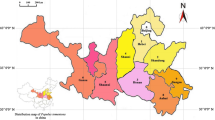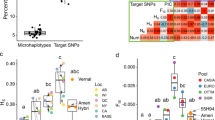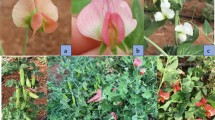Summary
For plant species in which a single cross pollination yields one or few seed and self pollination is easier, the families of the rather demanding triple test cross design can be replaced by their progeny families produced by selfing. The theoretical consequences of making this substitution on the sensitivity of the tests for epistasis and on the reliability of the estimates of the additive and dominance components of variation in the presence and absence of epistasis are described for F2 and F∞ populations. The practical consequences are illustrated by comparative analyses of normal families of a triple test cross and their selfs for the F∞ population using a population of 80 F13 families produced from a cross between varieties 1 and 5 of Nicotiana rustica.
Both in theory and in practice the additive genetic component D is detected and estimated with similar reliabilities from the normal families of a triple test cross and their selfs. On the other hand, the dominance component H is detected and estimated with much lower reliability from the selfs and in the presence of epistasis the estimate is more biased. The sensitivity of the standard test for epistasis is also lower for selfs but for an F∞ population this is partially offset by the additional test for epistasis involving the means of the F∞ families (P̄i) themselves.
In the comparative analyses family size and replications for the normal families and their selfs have been kept the same to make direct comparisons possible. In normal circumstances, however, one would not devote the time and effort required to produce the selfs unless as a result larger families and more replicates could be raised. Depending on the magnitude of the resulting increase in the number of plants raised the loss of reliability in the estimate of H and of sensitivity in the test for epistasis would be partly or wholly restored.
Similar content being viewed by others
Article PDF
References
Comstock, R E, and Robinson, H F. 1952. Estimation of average dominance of genes. Heterosis, Chapter 30, Iowa State College Press.
Jinks, J L. 1978. Unambiguous test for linkage of genes displaying non-allelic interactions for a metrical trait. Heredity, 40, 171–173.
Jinks, J L, and Perkins, J M. 1969. The detection of linked epistatic genes for a metrical trait. Heredity, 24, 465–475.
Jinks, J L, and Perkins, J M. 1970. A general method for the detection of additive, dominance and epistatic components of variation. III. F2 and backcross populations. Heredity, 25, 419–429.
Jinks, J L, Perkins, J M, and Breese, E L. 1969. A general method of detecting additive, dominance and epistatic variation for metrical traits. II. Application to inbred lines. Heredity, 24, 45–57.
Kearsey, M J, and Jinks, J L. 1968. A general method for the detection of additive, dominance and epistatic components of variation for metrical traits. I. Theory. Heredity, 23, 403–409.
Perkins, J M, and Jinks, J L. 1970. Detection and estimation of genotype-environmental, linkage and epistatic components of variation for a metrical trait. Heredity, 25, 157–177.
Pooni, H S, and Jinks, J L. 1976. The efficiency and optimal size of triple test cross designs for detecting epistatic variation. Heredity, 36, 215–227.
Pooni, H S, and Jinks, J L. 1979. Sources and biases of the predictors of the properties of recombinant inbreds produced by single seed descent. Heredity, 42, 41–48.
Pooni, H S, Jinks, J L, and Jayasekara, N E M. 1978. An investigation of gene action and genotype × environment interaction in two crosses of Nicotiana rustica by triple test cross and inbred line analysis. Heredity, 42, 41–48.
Snedecor, G W, and Cochran, W G. 1967. Statistical methods. Sixth Edition. Iowa State University Press.
Author information
Authors and Affiliations
Rights and permissions
About this article
Cite this article
Pooni, H., Jinks, J. & Pooni, G. A general method for the detection and estimation of additive, dominance and epistatic variation for metrical traits. Heredity 44, 177–192 (1980). https://doi.org/10.1038/hdy.1980.15
Received:
Issue date:
DOI: https://doi.org/10.1038/hdy.1980.15
This article is cited by
-
Epistasis in an Andean × Mesoamerican cross of common bean
Euphytica (2012)
-
Efficiency of triple test cross for detecting epistasis with marker information
Heredity (2007)
-
A general method of detecting additive, dominance and epistatic variation for metrical traits. V. Triple test cross analysis of disomically inherited traits expressed in triploid tissues
Heredity (1994)
-
The effects of major genes on quantitatively varying characters in barley. 4. The GPert and denso loci and quality characters
Heredity (1991)
-
The effects of major genes on quantitatively varying characters in barley.: III. The two row/six row locus (V–v)
Heredity (1990)



